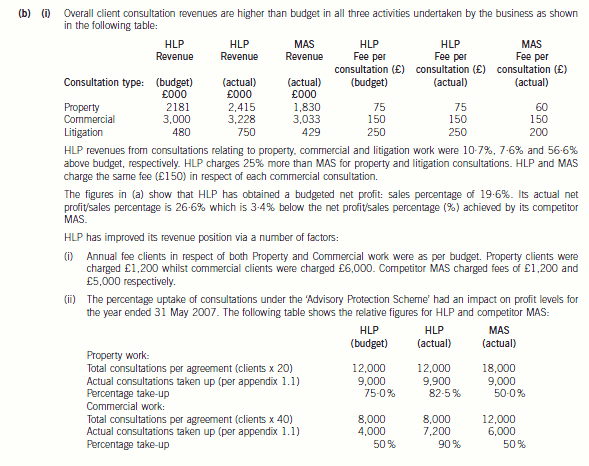(b) Using the information contained in Appendix 1.1, discuss the financial performance of HLP and MAS,
incorporating details of the following in your discussion:
(i) Overall client fees (total and per consultation)
(ii) Advisory protection scheme consultation ‘utilisation levels’ for both property and commercial clients
(iii) Cost/expense levels. (10 marks)

(ii) As far as annual agreements relating to property work are concerned, HLP had a take up rate of 82·5% whereas MAS
had a take up rate of only 50%. Therefore, HLP has ‘lost out’ to competitor MAS in relative financial terms as regards
the ‘take-up’ of consultations relating to property work. This is because both HLP and MAS received an annual fee from
each property client irrespective of the number of consultations given. MAS should therefore have had a better profit
margin from this area of business than HLP. However, the extent to which HLP has ‘lost out’ cannot be quantified since
we would need to know the variable costs per consultation and this detail is not available. What we do know is that
HLP earned actual revenue per effective consultation amounting to £90·90 whereas the budgeted revenue per
consultation amounted to £100. MAS earned £120 per effective consultation.
The same picture emerges from annual agreements relating to commercial work. HLP had a budgeted take up rate of
50%, however the actual take up rate during the period was 90%. MAS had an actual take up rate of 50%. The actual
revenue per effective consultation earned by HLP amounted to £167 whereas the budgeted revenue per consultation
amounted to £300. MAS earned £250 per effective consultation.
There could possibly be an upside to this situation for HLP in that it might be the case that the uptake of 90% of
consultations without further charge by clients holding annual agreements in respect of commercial work might be
indicative of a high level of customer satisfaction. It could on the other hand be indicative of a mindset which says ‘I
have already paid for these consultations therefore I am going to request them’.
(iii) Budgeted and actual salaries in HLP were £50,000 per annum, per advisor. Two additional advisors were employed
during the year in order to provide consultations in respect of commercial work. MAS paid a salary of £60,000 to each
advisor which is 20% higher than the salary of £50,000 paid to each advisor by HLP. Perhaps this is indicative that
the advisors employed by MAS are more experienced and/or better qualified than those employed by HLP.
HLP paid indemnity insurance of £250,000 which is £150,000 (150%) more than the amount of £100,000 paid by
MAS. This excess cost may well have arisen as a consequence of successful claims against HLP for negligence in
undertaking commercial work. It would be interesting to know whether HLP had been the subject of any successful
claims for negligent work during recent years as premiums invariably reflect the claims history of a business. Rather
worrying is the fact that HLP was subject to three such claims during the year ended 31 May 2007.
Significant subcontract costs were incurred by HLP during the year probably in an attempt to satisfy demand and retain
the goodwill of its clients. HLP incurred subcontract costs in respect of commercial properties which totalled £144,000.
These consultations earned revenue amounting to (320 x £150) = £48,000, hence a loss of £96,000 was incurred
in this area of the business.
HLP also paid £300,000 for 600 subcontract consultations in respect of litigation work. These consultations earned
revenue amounting to (600 x £250) = £150,000, hence a loss of £150,000 was incurred in this area of the business.
In contrast, MAS paid £7,000 for 20 subcontract consultations in respect of commercial work and an identical amount
for 20 subcontract consultations in respect of litigation work. These consultations earned revenue amounting to
20 x (£150 + £200) =£7,000. Therefore, a loss of only £7,000 was incurred in respect of subcontract consultations
by MAS.
Other operating expenses were budgeted at 53·0% of sales revenue. The actual level incurred was 40·7% of sales
revenue. The fixed/variable split of such costs is not given but it may well be the case that the fall in this percentage is
due to good cost control by HLP. However, it might simply be the case that the original budget was flawed. Competitor
MAS would appear to have a slightly superior cost structure to that of HLP since its other operating expenses amounted
to 38·4% of sales revenue. Further information is required in order to draw firmer conclusions regarding cost control
within both businesses.